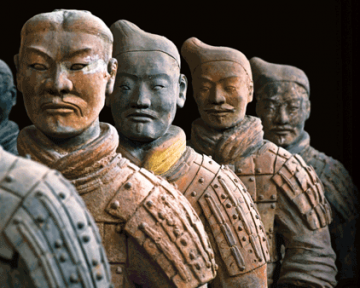Originally published in the Marina Times San Francisco in April 2013
Through May 27, 2013, The Asian Art Museum will have on display ten figures representing over 7,000 life-sized sculpted soldiers found in the tomb of China’s first emperor, Quin Shihuang.
The underground burial complex of Quin Shihuang was first unearthed in 1974, revealing an elaborate array of objects and images reminiscent of riches found in the tombs of the Egyptian pharaohs. The figures are life-sized and vary in height, uniform and hairstyle in accordance with rank. Each statue is unique, and was created in an assembly line style by laborers and artisans. Placement of the thousands of soldiers in the tomb was painstakingly ordered in terms of rank and duty.
Though they rotted and decayed over time, the terracotta warriors originally held real weapons such as spears, swords and crossbows. The military guard came accompanied with horses, cavalry, infantry and chariots. Details including slight variations in facial features and expressions were enhanced by lifelike paint that was applied in the finishing processes, later removed by time and erosion. Other figures were also found representing musicians, acrobats and other officials.
History remembers Quin Shihuang as a notorious tyrant obsessed with the idea that he could be assassinated. During his rule, he unified sections of the Great Wall of China. As a committed anti-intellectual, he outlawed and burned books as a means of controlling the population. The scholars who wrote them were sometimes burned alive as well. Construction of his elaborate tomb and mausoleum started after he began his reign at the age of 13. The endeavor required the work of 700,000 men. Construction of the tomb went on in secret, and most of the workmen involved were killed. Quin Shihuang’s later years were spent seeking immortality, and he died in 221BC after ingesting mercury pills that, paradoxically, were intended to make him immortal.
The ruler who sought eternal life and feared assassination is now remembered for his warriors, a frozen army keeping silent watch over him in the afterlife. The Asian Museum’s terracotta warriors present an opportunity to observe an ambitious example of funerary art and the troubled legacy of China’s first emperor.